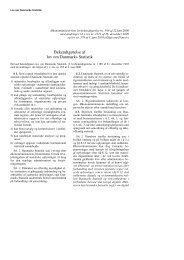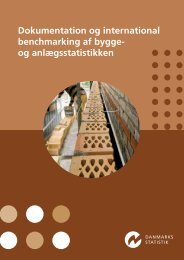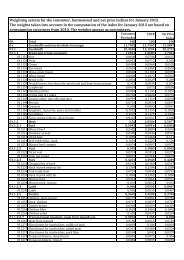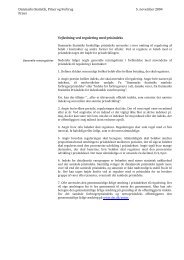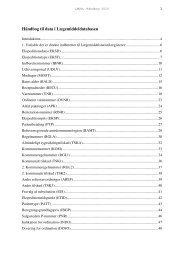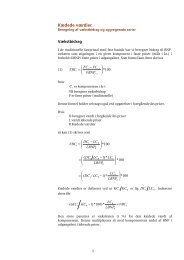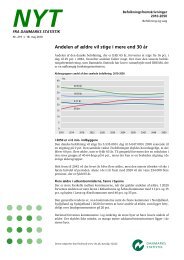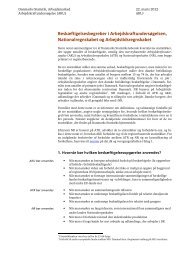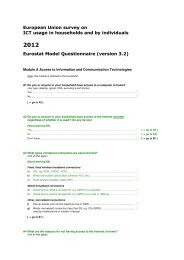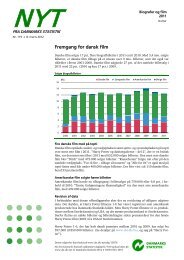Technological development and the vision of an archive statistical ...
Technological development and the vision of an archive statistical ...
Technological development and the vision of an archive statistical ...
You also want an ePaper? Increase the reach of your titles
YUMPU automatically turns print PDFs into web optimized ePapers that Google loves.
Dok nor 9, 28/07/10<br />
<strong>Technological</strong> <strong>development</strong> <strong><strong>an</strong>d</strong> <strong>the</strong> <strong>vision</strong> <strong>of</strong> <strong>an</strong> <strong>archive</strong> <strong>statistical</strong><br />
system in Statistics Norway<br />
Rune Gløersen, Olav Bjerkholt, Svein Gåsemyr <strong><strong>an</strong>d</strong> Jenny Linnerud, Statistics Norway<br />
1 Introduction<br />
At <strong>the</strong> tri-<strong>an</strong>nual meeting <strong>of</strong> Nordic statistici<strong>an</strong>s in Helsinki 1960 Svein Nordbotten <strong>of</strong><br />
Statistics Norway presented his ideas <strong><strong>an</strong>d</strong> <strong>vision</strong> for <strong>an</strong> <strong>archive</strong> <strong>statistical</strong> system, [1]. The<br />
presentation led to similar activities in all Nordic countries, where <strong>the</strong> respective national<br />
<strong>statistical</strong> institutes (NSIs) initiated early steps in a <strong>development</strong> towards <strong>an</strong> <strong>archive</strong> <strong>statistical</strong><br />
system as outlined by Nordbotten, see e.g. [4]. The 1960 presentation thus became <strong>the</strong> starting<br />
point for <strong>the</strong> <strong>development</strong> <strong>of</strong> what has become known as <strong>the</strong> Nordic approach to <strong>of</strong>ficial<br />
statistics. An English version <strong>of</strong> parts <strong>of</strong> <strong>the</strong> 1960 paper was published in 1966, [2], see also<br />
[3]. Nordbotten defined <strong>an</strong> <strong>archive</strong> <strong>statistical</strong> system as “a production <strong>of</strong> statistics with<br />
continuous compilation <strong>of</strong> data independent <strong>of</strong> <strong>the</strong> traditional <strong>statistical</strong> br<strong>an</strong>ches <strong><strong>an</strong>d</strong> census<br />
dates <strong><strong>an</strong>d</strong> where <strong>the</strong> processing <strong>of</strong> <strong>the</strong> filed material is undertaken as <strong>the</strong> user needs arise <strong><strong>an</strong>d</strong><br />
completely independent <strong>of</strong> <strong>the</strong> compilation.” In more recent terminology register based<br />
statistics has been used as <strong>an</strong> expression which, even if not perfectly coinciding with<br />
Nordbotten’s ideas as originally stated, covers <strong>the</strong> core content <strong>of</strong> <strong>the</strong>se.<br />
The technological <strong>development</strong> in Statistics Norway since <strong>the</strong> 1960s discussed in this paper is<br />
viewed to a large extent as to whe<strong>the</strong>r it has been conducive <strong><strong>an</strong>d</strong> supportive <strong>of</strong> promoting <strong><strong>an</strong>d</strong><br />
fulfilling Nordbotten’s <strong>vision</strong>. It is a history <strong>of</strong> ups <strong><strong>an</strong>d</strong> downs, coloured by optimism <strong><strong>an</strong>d</strong><br />
pessimism. However, it should be noted that import<strong>an</strong>t elements <strong>of</strong> <strong>the</strong> <strong>archive</strong> <strong>statistical</strong><br />
system are not dependent on specific technological <strong>development</strong>s. The fascinating emergence<br />
<strong>of</strong> computer technology, still at <strong>an</strong> embryonic stage in <strong>the</strong> late 1950s, may have served as a<br />
catalyst for Nordbotten to form his <strong>vision</strong>, <strong><strong>an</strong>d</strong> <strong>the</strong> ensuing technological <strong>development</strong> as <strong>an</strong><br />
enabler to reach import<strong>an</strong>t objectives, but <strong>the</strong> main obstacle for <strong>an</strong> overall implementation <strong>of</strong><br />
<strong>the</strong> <strong>vision</strong> <strong><strong>an</strong>d</strong> <strong>the</strong> reason for its lack <strong>of</strong> fulfillment has not been technological.<br />
2 Early <strong>development</strong>s<br />
2.1 Towards <strong>the</strong> universal machine<br />
Before 1940, compilation <strong>of</strong> <strong>of</strong>ficial statistics was mainly based on m<strong>an</strong>ual grouping <strong><strong>an</strong>d</strong><br />
counting <strong>of</strong> paper forms for <strong>statistical</strong> surveys, <strong>statistical</strong> censuses <strong><strong>an</strong>d</strong> administrative sources.<br />
The US Bureau <strong>of</strong> Census started to use punch card machines for <strong>the</strong> 1890 Population Census.<br />
Statistics Norway acquired Hollerith punch card machines in 1894 (several keypunches, a<br />
sorter <strong><strong>an</strong>d</strong> a tabulator), in preparation for <strong>the</strong> Norwegi<strong>an</strong> 1900 Population Census. On a large<br />
scale m<strong>an</strong>ual methods were not replaced by punch card machines until <strong>the</strong> 1940s <strong><strong>an</strong>d</strong> 1950s.<br />
By <strong><strong>an</strong>d</strong> large, we c<strong>an</strong> say that <strong>the</strong> 1950s represent <strong>the</strong> culmination <strong>of</strong> <strong>the</strong> era <strong>of</strong> <strong>the</strong> punch card<br />
machines. At <strong>the</strong> same time, from <strong>the</strong> very beginning <strong>of</strong> <strong>the</strong> decade, <strong>the</strong> interest in emerging<br />
universal electronic computers started, in <strong>the</strong> wake <strong>of</strong> <strong>the</strong> pioneering <strong>development</strong> in <strong>the</strong> USA<br />
1
in <strong>the</strong> immediate postwar period. Statistics Norway became one <strong>of</strong> <strong>the</strong> front runners among<br />
national <strong>statistical</strong> institutes in Europe in taking first-generation computers in use for<br />
<strong>statistical</strong> purposes, [5], [6a] <strong><strong>an</strong>d</strong> [6b].<br />
A punch card machine was specialized to work out a st<strong><strong>an</strong>d</strong>ard process. The <strong>statistical</strong><br />
production was org<strong>an</strong>ized as a sequential chain <strong>of</strong> processes using different kinds <strong>of</strong> punch<br />
card equipment. The processing sequence could typically be:<br />
The keypunch tr<strong>an</strong>sferred information from paper documents to cards<br />
The verifier accepted punched cards for re-keying. Erroneous cards were re-punched<br />
The sorter sequenced cards into <strong>an</strong>y <strong>of</strong> 80 columns. The cards were routed into <strong>the</strong><br />
correct pocket<br />
The collator sequence-checked, merged, matched, <strong><strong>an</strong>d</strong> selected cards<br />
The reproducer reproduced duplicate cards, punching copied detail cards from a<br />
single master card, performed mark sensing, <strong><strong>an</strong>d</strong> summary punching<br />
The calculator was capable <strong>of</strong> addition, subtraction, multiplication <strong><strong>an</strong>d</strong> di<strong>vision</strong><br />
The tabulating machine was capable <strong>of</strong> adding, subtracting, summarizing totals <strong><strong>an</strong>d</strong><br />
printing tabulated reports<br />
O<strong>the</strong>r machines like <strong>the</strong> Summary punch <strong><strong>an</strong>d</strong> <strong>the</strong> Interpreter were also used for specific<br />
purposes. In 1950, Statistics Norway procured <strong>the</strong> famous IBM 101 (Electronic Statistical<br />
Machine) that could count <strong><strong>an</strong>d</strong> summarize <strong><strong>an</strong>d</strong> in parallel, sort <strong>the</strong> cards <strong><strong>an</strong>d</strong> print tables on<br />
paper.<br />
A universal machine that could work out all or several <strong>of</strong> <strong>the</strong>se functions did not exist, but<br />
became a <strong>vision</strong> for <strong>the</strong> expectations <strong>of</strong> future possibilities, see [6b].<br />
Preparatory investigations <strong>of</strong> <strong>the</strong> possibilities for getting access to a universal electronic<br />
computer started in Statistics Norway soon after Nordbotten started working <strong>the</strong>re, in 1952.<br />
M<strong>an</strong>y had read popular <strong><strong>an</strong>d</strong> speculative articles about ENIAC <strong><strong>an</strong>d</strong> o<strong>the</strong>r pioneering efforts.<br />
Ragnar Frisch at <strong>the</strong> Institute <strong>of</strong> Economics at <strong>the</strong> University <strong>of</strong> Oslo, who had close relations<br />
with Statistics Norway, had established contact with prominent US researchers in <strong>the</strong> field for<br />
his own interest in numerical <strong>an</strong>alysis for economic modelling. Petter Jakob Bjerve, <strong>the</strong><br />
Director General <strong>of</strong> Statistics Norway from 1949, had spent 1947-49 at economic research<br />
centres in <strong>the</strong> USA. It became quickly known that <strong>the</strong> most import<strong>an</strong>t Americ<strong>an</strong> <strong>statistical</strong><br />
institution, Bureau <strong>of</strong> Census, in 1951 had acquired <strong>the</strong> first commercially available<br />
computer, Univac 1, for its <strong>statistical</strong> work. Nordbotten became involved in <strong>the</strong> discussions <strong>of</strong><br />
computers at <strong>an</strong> early stage <strong><strong>an</strong>d</strong> after only one year in Statistics Norway, he was sent to <strong>the</strong><br />
USA fin<strong>an</strong>ced by a program for exch<strong>an</strong>ge <strong>of</strong> civil serv<strong>an</strong>ts under <strong>the</strong> Marshall Pl<strong>an</strong>, see [7].<br />
O<strong>the</strong>r staff members were also sent on similar missions <strong><strong>an</strong>d</strong> US experts involved in inputoutput<br />
<strong>an</strong>alysis visited Norway.<br />
The briefings <strong><strong>an</strong>d</strong> information ga<strong>the</strong>red through <strong>the</strong>se study visits about computers was<br />
import<strong>an</strong>t at a time when computers were not yet available commercially. The deliberations<br />
within Statistics Norway about computers went clearly in <strong>the</strong> direction that it would be <strong>of</strong><br />
great interest to look fur<strong>the</strong>r into <strong>the</strong> possibilities for taking computers into use both for<br />
<strong>statistical</strong> purposes <strong><strong>an</strong>d</strong> for research. The acquisition <strong>of</strong> a computer would, however, require<br />
<strong>an</strong> investment <strong>of</strong> subst<strong>an</strong>tial funds <strong><strong>an</strong>d</strong> would not be possible without approval <strong><strong>an</strong>d</strong> funding<br />
decided at a high political level. From 1956 Nordbotten was put in charge <strong>of</strong> pl<strong>an</strong>ning <strong><strong>an</strong>d</strong><br />
2
preparation in connection with <strong>the</strong> possible future acquisition <strong><strong>an</strong>d</strong> use <strong>of</strong> computers in<br />
Statistics Norway. This comprised <strong>the</strong> making <strong>of</strong> a comparative survey <strong>of</strong> available<br />
computers. The preparatory process ended successfully in permission by <strong>the</strong> government <strong><strong>an</strong>d</strong><br />
funds secured for procuring <strong>the</strong> computer DEUCE produced by English Electric. The ultimate<br />
decision was made by <strong>the</strong> Storting (Parliament) in May 1958. The huge computer was put in<br />
place in Statistics Norway’s quarters <strong><strong>an</strong>d</strong> was in operation from February 1959. Nordbotten<br />
was in charge <strong>of</strong> supervising <strong>the</strong> installation, <strong><strong>an</strong>d</strong> later <strong>the</strong> programming work <strong><strong>an</strong>d</strong> <strong>the</strong><br />
operation <strong>of</strong> DEUCE <strong><strong>an</strong>d</strong> also o<strong>the</strong>r computer equipment.<br />
DEUCE was at <strong>the</strong> time a fast <strong><strong>an</strong>d</strong> powerful computer using a magnetic drum for storage <strong><strong>an</strong>d</strong><br />
needless to say, with ra<strong>the</strong>r limited memory capacity. Input <strong><strong>an</strong>d</strong> output was only by punched<br />
cards, no printers attached. Already in 1961 Statistics Norway purchased <strong>an</strong> IBM 1401<br />
computer, which introduced high speed input/output data tr<strong>an</strong>sfer <strong><strong>an</strong>d</strong> high storage capacity<br />
using 4 magnetic tape drives. In addition <strong>the</strong> IBM 1401 operated a 600 line pr. minute printer.<br />
The two computers were used to complement one <strong>an</strong>o<strong>the</strong>r, <strong><strong>an</strong>d</strong> toge<strong>the</strong>r <strong>the</strong>y formed at least<br />
<strong>the</strong> chimera <strong>of</strong> <strong>the</strong> functions <strong>of</strong> <strong>the</strong> universal machine. DEUCE was scrapped in 1965 <strong><strong>an</strong>d</strong><br />
replaced by <strong>an</strong> IBM 360/40 in 1966; <strong>the</strong> era <strong>of</strong> <strong>the</strong> mainframe had begun.<br />
Never<strong>the</strong>less, from 1961 <strong>the</strong> technology was present in terms <strong>of</strong> functionality <strong><strong>an</strong>d</strong> capacity to<br />
be able to start to implement <strong>the</strong> ideas <strong>of</strong> <strong>the</strong> <strong>archive</strong> <strong>statistical</strong> system on a larger scale.<br />
2.2 Background for <strong>the</strong> idea <strong>of</strong> <strong>the</strong> <strong>archive</strong> <strong>statistical</strong> system<br />
In a presentation for <strong>the</strong> Director Generals <strong>of</strong> Nordic NSIs, 1966 [8], Svein Nordbotten stated<br />
that <strong>the</strong> ideas <strong>of</strong> <strong>the</strong> 1960 presentation on <strong>archive</strong> <strong>statistical</strong> system were not new. He referred<br />
to <strong>an</strong> ISI report <strong>of</strong> 1872: “Registre de Population” <strong><strong>an</strong>d</strong> commented: “The great difference,<br />
however, is that today we may be able to implement <strong>the</strong>se ideas”. This also illustrates how<br />
technological <strong>development</strong>s influence non-technological challenges.<br />
Of more interest should be that in 1959, <strong>the</strong> Americ<strong>an</strong> Economic Association (AEA)<br />
considered <strong>the</strong> need for preservation <strong><strong>an</strong>d</strong> use <strong>of</strong> micro data files for economic research. The<br />
AEA recommended that <strong>the</strong> Social Science Research Council set up a Committee to study this<br />
problem <strong><strong>an</strong>d</strong> undertake a program <strong>of</strong> action. The report <strong>of</strong> this initiative was published in<br />
1965, see chapter 5.2 below.<br />
When a <strong>statistical</strong> micro file was stored on punch cards, <strong>the</strong> cost <strong>of</strong> reuse <strong>of</strong> data was limited<br />
by <strong>the</strong> cost <strong>of</strong> using punch card machines to access <strong>the</strong> data <strong><strong>an</strong>d</strong> to link to o<strong>the</strong>r files.<br />
Compared with <strong>the</strong> cost <strong>of</strong> reusing information directly from paper questionnaires, which<br />
could be <strong>of</strong> <strong>the</strong> same order as <strong>the</strong> original cost <strong>of</strong> processing <strong>the</strong> survey, <strong>the</strong> use <strong>of</strong> punch card<br />
was a major achievement, also with respect to <strong>the</strong> potential reuse <strong>of</strong> information. In practice<br />
<strong>the</strong>se possibilities were not utilized. For example: to execute one run <strong>of</strong> <strong>the</strong> micro file <strong>of</strong> <strong>the</strong><br />
Norwegi<strong>an</strong> 1950 Population Census, 8000 kilograms <strong>of</strong> punch cards had to be moved from<br />
<strong>the</strong> <strong>archive</strong> – in <strong><strong>an</strong>d</strong> out <strong>of</strong> <strong>the</strong> several punch card machines – <strong><strong>an</strong>d</strong> finally back to <strong>the</strong> <strong>archive</strong>.<br />
To update <strong>the</strong> <strong>statistical</strong> information about <strong>the</strong> population on a regular basis, which is<br />
basically <strong>the</strong> idea behind <strong>the</strong> <strong>archive</strong> <strong>statistical</strong> system, would require frequent operations <strong>of</strong><br />
this kind.<br />
The logistics in dividing a dataset for a population census into smaller sets which were more<br />
practical to h<strong><strong>an</strong>d</strong>le, <strong><strong>an</strong>d</strong> at <strong>the</strong> same time exploiting <strong>the</strong> capacity <strong>of</strong> <strong>the</strong> different machines <strong><strong>an</strong>d</strong><br />
3
keeping track <strong>of</strong> <strong>the</strong> status <strong>of</strong> <strong>the</strong> different subsets <strong><strong>an</strong>d</strong> <strong>the</strong>ir whereabouts, were discouraging.<br />
When magnetic tapes were <strong>the</strong> main tool for sorting <strong><strong>an</strong>d</strong> linking stored <strong>statistical</strong> micro files,<br />
reuse <strong>of</strong> <strong>the</strong>se files became a much more attractive option. To be able to establish <strong><strong>an</strong>d</strong><br />
maintain a data <strong>archive</strong> with <strong>the</strong> purpose <strong>of</strong> fur<strong>the</strong>r <strong><strong>an</strong>d</strong> future utilization <strong>of</strong> <strong>the</strong> collected<br />
information required <strong>the</strong> following:<br />
• A perm<strong>an</strong>ent <strong><strong>an</strong>d</strong> stable identification <strong>of</strong> <strong>the</strong> basic <strong>statistical</strong> units.<br />
• St<strong><strong>an</strong>d</strong>ardisation <strong>of</strong> <strong>the</strong> definitions <strong><strong>an</strong>d</strong> characteristics <strong>of</strong> <strong>the</strong> unit attributes<br />
• Time specification <strong>of</strong> <strong>the</strong> observed value for <strong>the</strong>se attributes<br />
The idea <strong>of</strong> <strong>an</strong> <strong>archive</strong> <strong>statistical</strong> was elaborated in different papers towards a descriptive<br />
model named The Statistical File System, abbreviated SFS hereafter, was described as a “data<br />
box” with <strong>the</strong> above three dimensions. The SFS in a way introduced <strong>an</strong>o<strong>the</strong>r main objective<br />
for a <strong>statistical</strong> institution; in addition to producing statistics, keeping <strong>an</strong> <strong>archive</strong> <strong>of</strong> <strong>the</strong><br />
collected micro data for secondary use became a clearly defined task.<br />
These ideas were not new, but since <strong>the</strong>y now could be realized by <strong>the</strong> use <strong>of</strong> <strong>the</strong> emerging<br />
technology, <strong>the</strong> need to describe <strong><strong>an</strong>d</strong> structure <strong>the</strong>se needs into a consistent model <strong>of</strong> <strong>an</strong><br />
<strong>archive</strong> system became evident. The papers on SFS, [9], form a ra<strong>the</strong>r complete information<br />
model that links directly to our current challenges <strong><strong>an</strong>d</strong> <strong>development</strong>s in <strong>the</strong> society <strong>of</strong><br />
<strong>statistical</strong> institutes. See figure 1, as copied [9], giving <strong>an</strong> example <strong>of</strong> one “record” in <strong>the</strong> data<br />
box which holds <strong>the</strong> observed value at a specific time for <strong>the</strong> <strong>statistical</strong> characteristic<br />
“income” <strong>of</strong> <strong>the</strong> (<strong>statistical</strong>) unit “Person A”.<br />
FIGURE 1. The Data Box <strong><strong>an</strong>d</strong> <strong>the</strong> Storage <strong>of</strong> Income X for person A in 1966<br />
4
2.3 The implication <strong><strong>an</strong>d</strong> role <strong>of</strong> IT<br />
As mentioned, <strong>the</strong> SFS was presented by Nordbotten around 1960, when <strong>the</strong> first computers<br />
were installed in Statistics Norway. One question striking <strong>an</strong>yone who reads <strong>the</strong> papers about<br />
<strong>the</strong> SFS in retrospect, is how it was possible to foresee <strong>the</strong> possibilities <strong>of</strong> <strong>the</strong> new<br />
technologies at such <strong>an</strong> early stage. This question c<strong>an</strong> only be <strong>an</strong>swered by one person, but<br />
one reason is perhaps that <strong>the</strong> new technology did not come completely out <strong>of</strong> <strong>the</strong> blue. The<br />
computers did actually carry out <strong>the</strong> same tasks as <strong>the</strong> various punch card machines did<br />
before, just with <strong>an</strong> impressive higher speed <strong><strong>an</strong>d</strong> with <strong>the</strong> possibility to carry out more th<strong>an</strong><br />
one task at a time, <strong><strong>an</strong>d</strong> with <strong>the</strong> ability to store <strong><strong>an</strong>d</strong> retrieve data with fewer m<strong>an</strong>ual<br />
operations. The processing capacity increased exponentially, giving <strong>the</strong> opportunity to carry<br />
out calculations that hardly were possible beforeh<strong><strong>an</strong>d</strong>, not because <strong>the</strong>y were not thought <strong>of</strong>,<br />
but <strong>the</strong>y took more time th<strong>an</strong> was considered reasonable for <strong>the</strong> outcome <strong>of</strong> <strong>the</strong> task.<br />
Fur<strong>the</strong>rmore, <strong>the</strong> storage capacity was immense compared to <strong>the</strong> old punch cards. It could be<br />
noted though that <strong>the</strong> technical jargon was to a fair extent a continuation from that <strong>of</strong> <strong>the</strong><br />
punch card machines.<br />
Would it have been possible to establish <strong><strong>an</strong>d</strong> maintain a complete, coherent <strong>archive</strong> <strong>of</strong> all<br />
<strong>statistical</strong> units, <strong>the</strong>ir characteristic attributes <strong><strong>an</strong>d</strong> <strong>the</strong> observed attribute values at <strong>an</strong>y specific<br />
point <strong>of</strong> time, at <strong>the</strong> time when <strong>the</strong>se ideas were launched?<br />
From a storage point <strong>of</strong> view, <strong>the</strong> <strong>an</strong>swer is yes. The SFS is a system, a principle <strong>of</strong> data<br />
archiving, where <strong>the</strong> <strong>archive</strong> could be broken down into more domain specific cubes or boxes.<br />
We should also consider <strong>the</strong> fact that from <strong>the</strong> beginning, IT delivered services to store at <strong>an</strong>y<br />
time all data retrieved <strong><strong>an</strong>d</strong> to process all <strong>statistical</strong> information requested. However, within<br />
service levels not always found acceptable to <strong>the</strong> end users. The SFS system was challenging<br />
in m<strong>an</strong>y aspects, but it would also have led to less duplication <strong>of</strong> stored data, <strong><strong>an</strong>d</strong> to <strong>an</strong> early<br />
possibility <strong>of</strong> concentrating efforts <strong><strong>an</strong>d</strong> resources around more common, cross sectional<br />
production systems.<br />
In a way, <strong>the</strong> feasibility had already been shown by <strong>the</strong> fact that Statistics Norway had kept a<br />
<strong>statistical</strong> Business Register since <strong>the</strong> business census in 1953. The register was maintained<br />
on punch cards until 1965, with regular updates from various sources, leaving no doubt that<br />
technology was not <strong>an</strong> obstacle in itself.<br />
From 1964 <strong>the</strong> Central Population Register (CPR) was in operation. The task <strong>of</strong> <strong>the</strong> CPR was<br />
to assign <strong>of</strong>ficial <strong><strong>an</strong>d</strong> unique PIN, (Person Identification Number). The PIN was needed by<br />
businesses to reduce response burden <strong><strong>an</strong>d</strong> by government agencies to establish electronic<br />
administrative data system. The CPR was <strong>the</strong> first register based on continuous updates,<br />
established as a system <strong>of</strong> chronological files, following <strong>the</strong> principles <strong>of</strong> <strong>the</strong> SFS. This was<br />
first implemented on <strong>the</strong> IBM 1401, on a machine which we today c<strong>an</strong> hardly believe was<br />
able to cope with such a task. Once again, technology showed <strong>the</strong> possibilities.<br />
However, technology also represented a bumpy road. The update <strong>of</strong> <strong>the</strong> chronological file was<br />
time consuming, <strong>the</strong> secondary usage perhaps not very comprehensive. This is reflected in<br />
Nordbotten’s papers, where <strong>the</strong> pl<strong>an</strong>s <strong><strong>an</strong>d</strong> <strong>development</strong>s are always accomp<strong>an</strong>ied by a<br />
roadmap on expected technological <strong>development</strong>s. It is obvious that <strong>the</strong> <strong>development</strong>s were<br />
needed in order to enh<strong>an</strong>ce <strong>the</strong> speed <strong><strong>an</strong>d</strong> functionality during update <strong><strong>an</strong>d</strong> retrieval <strong>of</strong> data in<br />
<strong>the</strong> <strong>archive</strong>. Therefore, already in <strong>the</strong> late 1960s, Statistics Norway discussed pl<strong>an</strong>s for<br />
5
moving <strong>the</strong> CPR to a database platform, or at least to move it onto <strong>the</strong> on-line, r<strong><strong>an</strong>d</strong>om access<br />
disc systems, [6].<br />
Nordbotten outlined <strong>the</strong> SFS as a system <strong>of</strong> hierarchical files, [9] as shown below in figure 2.<br />
FIGURE 2. File Hierarchy<br />
Statistics Norway implemented a naming convention st<strong><strong>an</strong>d</strong>ard for file labelling in <strong>the</strong> 1960s<br />
based on this. Most likely, <strong>the</strong> SFS principles were just implemented on <strong>the</strong> surface. The<br />
logical relations in <strong>the</strong> hierarchy, based upon precise, content based references between data<br />
elements <strong><strong>an</strong>d</strong> files were most likely not followed. This would have required a supportive<br />
documentation system, which to our knowledge did not exist, o<strong>the</strong>r th<strong>an</strong> as paper templates<br />
for file descriptions. An implementation <strong>of</strong> such a system would have resulted in <strong>an</strong><br />
elaboration <strong>of</strong> what Nordbotten described in 1967 as a “Data Description L<strong>an</strong>guage”, later on<br />
renamed by Bo Sundgren as “Metadata” which has become international terminology.<br />
Throughout <strong>the</strong> 1960s, under <strong>the</strong> super<strong>vision</strong> <strong>of</strong> Svein Nordbotten <strong><strong>an</strong>d</strong> with a great<br />
m<strong>an</strong>agement support by Director General Petter Jakcob Bjerve, Statistics Norway continued<br />
to establish <strong><strong>an</strong>d</strong> enh<strong>an</strong>ce <strong>the</strong> base registers. The need for registers in addition to base registers<br />
on person <strong><strong>an</strong>d</strong> business in areas like l<strong><strong>an</strong>d</strong> properties <strong><strong>an</strong>d</strong> buildings, education, employment etc<br />
was outlined. These registers are now well established <strong><strong>an</strong>d</strong> m<strong>an</strong>aged <strong><strong>an</strong>d</strong> maintained outside<br />
Statistics Norway, <strong><strong>an</strong>d</strong> form <strong>the</strong> base register infrastructure that is typical for <strong>the</strong> Nordic<br />
countries, extremely pr<strong>of</strong>itable for <strong>the</strong> statistics production, [12] <strong><strong>an</strong>d</strong> [15].<br />
At this stage, in <strong>the</strong> beginning <strong>of</strong> <strong>the</strong> 1970s, Statistics Norway was more or less forced into<br />
outsourcing <strong>of</strong> <strong>the</strong> IT services to <strong>the</strong> newly established Government Data Centre (GDC). The<br />
GDC decided, based on a tender, to procure a Honeywell Bull mainframe. This was almost<br />
disastrous for Statistics Norway. All available IT resources were put into a long term work on<br />
converting systems from our IBM environment, <strong><strong>an</strong>d</strong> more or less all innovations were put on<br />
hold. Core competence was lost, <strong><strong>an</strong>d</strong> a dark period for IT <strong>development</strong> in Statistics Norway<br />
started, which lasted for 10-20 years. This also coincides with Svein Nordbotten leaving<br />
Statistics Norway.<br />
An example <strong>of</strong> delay in <strong>development</strong> was that <strong>the</strong> pl<strong>an</strong>s in <strong>the</strong> late 1960s <strong>of</strong> moving <strong>the</strong> CPR<br />
onto a database platform did not become a reality until 1985. The CPR was <strong>the</strong>n developed on<br />
6
a Bull network database platform. This introduces a recurrent topic that always causes<br />
controversy among technologists; which technology is <strong>the</strong> best for a specific purpose?<br />
If we look at technological <strong>development</strong>s, in <strong>the</strong> end <strong>the</strong> brilli<strong>an</strong>t technologies do not always<br />
penetrate <strong>the</strong> market. Concerning network technology, Token Ring was sophisticated, but <strong>the</strong><br />
more primitive E<strong>the</strong>rnet won <strong>the</strong> market, TCP/IP was regarded a migration strategy towards<br />
X.400, but <strong>the</strong> ideal ISO st<strong><strong>an</strong>d</strong>ard more or less v<strong>an</strong>ished. Oracle was not <strong>the</strong> preferred choice<br />
<strong>of</strong> database experts never<strong>the</strong>less, it became <strong>the</strong> leading choice. No one could imagine <strong>the</strong><br />
b<strong><strong>an</strong>d</strong>width we now c<strong>an</strong> achieve using <strong>the</strong> simple copper telephone cables. A lesson that could<br />
be learnt from Nordbotten is to look beyond <strong>the</strong> limitations <strong>of</strong> existing technology is valuable<br />
at all times.<br />
The question about which type <strong>of</strong> database technology that has been regarded as best suited<br />
for <strong>statistical</strong> institutes has also caused a lot <strong>of</strong> debate. Network databases used physical<br />
pointers, which are pointers understood by <strong>the</strong> database m<strong>an</strong>agement system only, to locate<br />
<strong><strong>an</strong>d</strong> relate data. They were well suited for tr<strong>an</strong>saction based systems, but not equally good for<br />
traversing all data at one time. The relational database model constituted logical relations, but<br />
within a ra<strong>the</strong>r simple model, at <strong>the</strong> beginning suffering from bad perform<strong>an</strong>ce compared with<br />
existing hierarchical <strong><strong>an</strong>d</strong> network based systems. However, <strong>the</strong> principles were easier to<br />
underst<strong><strong>an</strong>d</strong>, <strong><strong>an</strong>d</strong> brought technology closer to <strong>the</strong> user.<br />
The Neuchâtel model for m<strong>an</strong>aging <strong>statistical</strong> classifications was first implemented in <strong>an</strong><br />
object oriented database system. When XML-oriented databases occurred, <strong>the</strong>y were found<br />
very promising for part <strong>of</strong> <strong>the</strong> <strong>statistical</strong> data. This reflects for inst<strong>an</strong>ce that up until now, <strong>the</strong><br />
technical database system has been discussed <strong><strong>an</strong>d</strong> regarded as closely related to <strong>the</strong><br />
complexity <strong>of</strong> <strong>the</strong> data models. The SFS in <strong>the</strong> end will be m<strong>an</strong>aged <strong><strong>an</strong>d</strong> structured by <strong>the</strong><br />
description <strong>of</strong> <strong>the</strong> content, which are <strong>the</strong> metadata <strong><strong>an</strong>d</strong> <strong>the</strong> structures <strong>of</strong> metadata. Nowadays,<br />
we see that this c<strong>an</strong> be achieved by using ra<strong>the</strong>r simple structures <strong>of</strong> <strong>the</strong> actual data, but<br />
maintaining <strong><strong>an</strong>d</strong> reflecting <strong>the</strong> logic, relations <strong><strong>an</strong>d</strong> <strong>the</strong> complexity <strong>of</strong> <strong>the</strong> information in <strong>the</strong><br />
interface that provides access to <strong>the</strong> metadata <strong><strong>an</strong>d</strong> data. The database itself is no longer <strong>the</strong><br />
core issue in <strong>the</strong> design <strong>of</strong> <strong>the</strong> systems.<br />
There is no doubt that <strong>the</strong> full realization <strong>of</strong> all <strong>vision</strong>s following <strong>the</strong> early thoughts <strong>of</strong> <strong>the</strong><br />
SFS would have required uptake <strong>of</strong> new technologies <strong><strong>an</strong>d</strong> would have been dependent on <strong>the</strong><br />
general <strong>development</strong> in terms <strong>of</strong> perform<strong>an</strong>ce <strong><strong>an</strong>d</strong> storage capacity etc at all times. The<br />
limitations <strong>of</strong> existing capacity in <strong>the</strong> IT systems should have led to tactical choices, but<br />
should never have influenced <strong>the</strong> overall objectives <strong><strong>an</strong>d</strong> strategies. An early decision to follow<br />
<strong>the</strong> principles, would have led to a stepwise <strong>development</strong> where a lot <strong>of</strong> <strong>the</strong> plurality, overlaps<br />
<strong><strong>an</strong>d</strong> stove pipes (traditional stovepipes, based on traditional <strong>statistical</strong> surveys, are org<strong>an</strong>ized<br />
by topics <strong><strong>an</strong>d</strong> contain all production steps from data collection to publishing, [16]), that we<br />
face today, could have been avoided. However, <strong>the</strong>re is also a tendency in all attempts<br />
observed to develop systems <strong><strong>an</strong>d</strong> <strong>the</strong> org<strong>an</strong>ization needed to fulfil <strong>the</strong> ideas, that <strong>the</strong>y were too<br />
ambitious <strong><strong>an</strong>d</strong> comprehensive. They became regarded more as revolutions th<strong>an</strong> evolutions,<br />
<strong>the</strong> latter actually being envisaged from <strong>the</strong> beginning.<br />
3 Metadata strategy <strong><strong>an</strong>d</strong> <strong>the</strong> uptake <strong>of</strong> <strong>the</strong> old <strong>vision</strong>s<br />
While <strong>the</strong> 1970s were spent on converting systems from IBM to Honeywell Bull, <strong>the</strong> 1980s<br />
were actually spent on moving back to IBM. Statistics Norway purchased <strong>an</strong> IBM mainframe<br />
7
for <strong>the</strong> 1980 Census. From 1982, systems started to be moved back to <strong>the</strong> IBM environment.<br />
By <strong>the</strong> end <strong>of</strong> <strong>the</strong> 1980s, Statistics Norway had two IBM mainframes, one in Oslo <strong><strong>an</strong>d</strong> one in<br />
Kongsvinger. Systems were actually not converted back from Honeywell Bull, but <strong>the</strong>y were<br />
to a large extent rewritten using <strong>the</strong> old system as <strong>the</strong> specification for <strong>the</strong> new one. However,<br />
database technology was introduced.<br />
The main target for <strong>the</strong> <strong>development</strong>s in <strong>the</strong> 1980s was to combine data registration <strong><strong>an</strong>d</strong> data<br />
editing in one operation. Looking back, this was not a particularly <strong>vision</strong>ary decision. First <strong>of</strong><br />
all, it led to a very slow uptake <strong>of</strong> using new <strong><strong>an</strong>d</strong> more effective <strong>statistical</strong> methods in data<br />
editing. Editing while punching data is slow <strong><strong>an</strong>d</strong> very resource dem<strong><strong>an</strong>d</strong>ing, <strong><strong>an</strong>d</strong> you spend<br />
equal amounts <strong>of</strong> resources on every unit irrespective <strong>of</strong> <strong>the</strong> impact on <strong>the</strong> total quality. The<br />
result was basically that every survey or <strong>statistical</strong> product got <strong>the</strong>ir own, proprietary system<br />
for data editing. This was definitely not in line with <strong>the</strong> ideas <strong>of</strong> Nordbotten.<br />
3.1 Out <strong>of</strong> <strong>the</strong> dark<br />
From <strong>the</strong> mid 1990s, Statistics Norway started <strong>development</strong>s in three basic areas which are<br />
related to <strong>the</strong> old set <strong>of</strong> ideas:<br />
• Dissemination systems <strong><strong>an</strong>d</strong> uptake <strong>of</strong> <strong>the</strong> Internet possibilities<br />
• Establishment <strong>of</strong> master metadata systems<br />
• Developments in data collection <strong><strong>an</strong>d</strong> reduction <strong>of</strong> <strong>the</strong> response burden<br />
We leave aside <strong>the</strong> issue <strong>of</strong> dissemination systems here, <strong>the</strong> o<strong>the</strong>r initiatives were both<br />
directly related to <strong>the</strong> ideas put forth by Nordbotten. Statistics Norway had ended up being<br />
very stove piped, while <strong>the</strong> pressure on better availability to <strong>statistical</strong> information, more<br />
flexibility in combining information, <strong><strong>an</strong>d</strong> especially <strong>the</strong> pressure on collecting one piece <strong>of</strong><br />
information once <strong><strong>an</strong>d</strong> later on reusing it for m<strong>an</strong>y purposes was increasing. A coherent<br />
<strong>statistical</strong> production system was needed. The foundation needed to begin this work was to<br />
establish <strong>the</strong> principles <strong><strong>an</strong>d</strong> elements <strong>of</strong> a complete metadata system.<br />
3.2 Metadata <strong>development</strong>s<br />
The basic idea behind <strong>the</strong> <strong>statistical</strong> file system is to store <strong>statistical</strong> micro files in such a way<br />
that <strong>the</strong>y c<strong>an</strong> easily be reused. Statistical micro files must be linked at unit level to <strong>the</strong> actual<br />
base register, to micro files <strong>of</strong> o<strong>the</strong>r <strong>statistical</strong> domains <strong><strong>an</strong>d</strong> to <strong>the</strong> same file for <strong>an</strong>o<strong>the</strong>r<br />
reference period. A prerequisite to do this is st<strong><strong>an</strong>d</strong>ard definition <strong>of</strong> units <strong><strong>an</strong>d</strong> variables <strong><strong>an</strong>d</strong> <strong>an</strong><br />
efficient metadata information system for Statistics Norway. Statistics Norway pl<strong>an</strong>ned to<br />
develop a common documentation system including a catalog <strong>of</strong> variables in <strong>the</strong> 1960s, but<br />
<strong>the</strong> project never took <strong>of</strong>f.<br />
The documentation <strong>of</strong> <strong>the</strong> database for <strong>the</strong> 1980 population Census was based on a virtual<br />
storage access method file system, (IBM VSAM). The experience <strong>of</strong> <strong>the</strong> 1980 Census was<br />
used to develop a database system for population statistics. The new systems were closely<br />
linked to <strong>the</strong> <strong>development</strong> <strong>of</strong> <strong>the</strong> first attempt to create a common metadata system in<br />
Statistics Norway – BIMS. The idea <strong>of</strong> BIMS was to have a system that could not only store<br />
<strong><strong>an</strong>d</strong> reuse <strong>the</strong> metadata, but also actively use <strong>the</strong>m in production. New micro files could be<br />
created by selecting variables from different files, <strong><strong>an</strong>d</strong> new variables could be derived.<br />
However, this attempt was not a success, ei<strong>the</strong>r.<br />
Statistics Norway has in <strong>the</strong> course <strong>of</strong> time developed m<strong>an</strong>y different metadata systems. This<br />
led to <strong>the</strong> same information being stored several times in several places making <strong>the</strong><br />
8
availability <strong>of</strong> updated <strong><strong>an</strong>d</strong> consistent information difficult. In recent years, <strong>the</strong>re has been a<br />
strong focus on <strong>the</strong> need to link existing systems <strong><strong>an</strong>d</strong> a requirement that new metadata<br />
systems should not be built in isolation. To facilitate this, Statistics Norway developed a<br />
metadata strategy, which was approved early in 2005. The strategy focuses on establishing a<br />
conceptual framework, clear roles <strong><strong>an</strong>d</strong> responsibilities, <strong><strong>an</strong>d</strong> a stepwise <strong>development</strong> involving<br />
integration <strong><strong>an</strong>d</strong> linkage <strong>of</strong> systems.<br />
The current objective <strong>of</strong> Statistics Norway's work on metadata is to develop <strong>an</strong> integrated<br />
metadata system that will contribute to effective <strong><strong>an</strong>d</strong> coherent statistics production <strong><strong>an</strong>d</strong><br />
dissemination, in addition to improved quality <strong>of</strong> statistics. Different metadata systems are<br />
being linked toge<strong>the</strong>r making <strong>the</strong> metadata more easily accessible for all users. Metadata<br />
should be updated only in one place.<br />
Current metadata systems:<br />
• Datadok – file descripions<br />
• Vardok – variables documentation system<br />
• Stabas – st<strong><strong>an</strong>d</strong>ard classification database<br />
• Metadb – metadata-base for event history data<br />
• Metadata Service library for <strong>the</strong> master systems<br />
• Metadata portal (implemented on Internet, under fur<strong>the</strong>r <strong>development</strong> on intr<strong>an</strong>et)<br />
3.3 Improved data collection <strong><strong>an</strong>d</strong> reduction <strong>of</strong> <strong>the</strong> response burden<br />
The o<strong>the</strong>r major idea <strong>of</strong> <strong>the</strong> SFS, that data collection could be regarded as a common process,<br />
establishing <strong>the</strong> micro data separate from <strong>the</strong> <strong>statistical</strong> <strong>an</strong>alysis, reflecting a view on <strong>the</strong> data<br />
<strong>archive</strong> as a growing data capital <strong>of</strong> <strong>the</strong> NSI, was not followed up from <strong>the</strong> beginning. In<br />
general, <strong>the</strong> uptake <strong>of</strong> <strong>the</strong> possibilities caused by <strong>the</strong> established registers in <strong>the</strong> <strong>statistical</strong><br />
production was ra<strong>the</strong>r modest. The registers served as frames for sampling, but sampling <strong><strong>an</strong>d</strong><br />
sample administration were not particularly st<strong><strong>an</strong>d</strong>ardised. Most opportunities were not fully<br />
explored.<br />
New technologies for data collection emerged with <strong>the</strong> Internet. Statistics Norway established<br />
from 2000 browser based solutions for data collection from electronic questionnaires in <strong>the</strong><br />
data reporting from municipalities <strong><strong>an</strong>d</strong> county administrations (Kostra system). From 2004,<br />
driven by a Government directive, all questionnaires within business statistics could be filled<br />
in electronically. This caused a centralisation <strong><strong>an</strong>d</strong> st<strong><strong>an</strong>d</strong>ardisation <strong>of</strong> <strong>the</strong> data collection<br />
systems. Direct reporting from business internal systems was introduced. This has led to<br />
improved use <strong>of</strong> <strong>the</strong> business register as <strong>the</strong> source for sample administration, <strong><strong>an</strong>d</strong> a reduction<br />
<strong>of</strong> <strong>the</strong> number <strong>of</strong> <strong>the</strong>se types <strong>of</strong> specialized systems throughout <strong>the</strong> org<strong>an</strong>ization. Equal<br />
improvements have been implemented with respect to <strong>the</strong> <strong>statistical</strong> CPR. The role <strong>of</strong><br />
m<strong>an</strong>aging <strong>the</strong> base Statistical Population registers have been signific<strong>an</strong>tly improved, now<br />
playing <strong>an</strong> import<strong>an</strong>t role in <strong>the</strong> coordinated use <strong><strong>an</strong>d</strong> reuse <strong>of</strong> <strong>the</strong> register based information.<br />
The pressure to reduce <strong>the</strong> response burden has led to coordinated efforts <strong><strong>an</strong>d</strong> <strong>development</strong>s<br />
across government agencies. A common portal for data reporting to <strong>the</strong> government sector<br />
was established in 2003 (Altinn). This portal has been fur<strong>the</strong>r developed, acting as a two way<br />
ch<strong>an</strong>nel for communication between businesses/citizens <strong><strong>an</strong>d</strong> <strong>the</strong> government sector. The<br />
improved usage has forced <strong>the</strong> public administrations not only to use a common ch<strong>an</strong>nel, but<br />
to actually harmonise <strong>the</strong>ir needs, <strong><strong>an</strong>d</strong> share <strong>the</strong> information provided by <strong>the</strong> users.<br />
9
For Statistics Norway this implies that more <strong><strong>an</strong>d</strong> more data will be collected <strong><strong>an</strong>d</strong> reused<br />
independently <strong>of</strong> <strong>the</strong> subsequent statistics production. Again, <strong>the</strong> <strong>vision</strong>s presented by<br />
Nordbotten are about to become a reality, driven by <strong>the</strong> Internet technology, government<br />
directives <strong><strong>an</strong>d</strong> <strong>the</strong> end user needs <strong><strong>an</strong>d</strong> preferences.<br />
4 Org<strong>an</strong>isational aspects<br />
4.1 Petter Jakob Bjerve on adapting <strong>the</strong> org<strong>an</strong>ization <strong>of</strong> national <strong>statistical</strong> institutes to<br />
technological <strong><strong>an</strong>d</strong> methodological <strong>development</strong><br />
Petter Jakob Bjerve became Director General <strong>of</strong> Statistics Norway in 1949 <strong><strong>an</strong>d</strong> took over <strong>an</strong><br />
institute that suffered from fairly limited org<strong>an</strong>izational <strong>development</strong> since it was founded in<br />
<strong>the</strong> 19th century. Bjerve, whose period as Director General lasted 31 years, worked very hard,<br />
particularly in <strong>the</strong> early part <strong>of</strong> his reign, to modernize <strong>the</strong> stove piped org<strong>an</strong>ization he had<br />
inherited. A joint programmatic paper by Bjerve <strong><strong>an</strong>d</strong> Nordbotten on automation <strong>of</strong> <strong>the</strong><br />
production <strong>of</strong> statistics in 1956, [5], initiated <strong>the</strong> discussion about a more functional<br />
org<strong>an</strong>ization. After having led Statistics Norway during its first steps into <strong>the</strong> computer era<br />
Bjerve presented to <strong>the</strong> Nordic Chief Statistici<strong>an</strong>s in 1963, [10], his views on <strong>the</strong> impact <strong>the</strong><br />
technological <strong>development</strong> ought to have on <strong>the</strong> org<strong>an</strong>izational structure <strong><strong>an</strong>d</strong> <strong>the</strong> di<strong>vision</strong> <strong>of</strong><br />
labour within <strong>the</strong> national <strong>statistical</strong> institute.<br />
Bjerve was well aware that <strong>the</strong>re was a lot more to come th<strong>an</strong> had been seen so far <strong>of</strong><br />
computer <strong>development</strong> <strong>of</strong> relev<strong>an</strong>ce for <strong>the</strong> production <strong>of</strong> statistics. By 1963 <strong>the</strong> computers<br />
had not yet made much impact on <strong>the</strong> org<strong>an</strong>ization <strong>of</strong> <strong>the</strong> <strong>statistical</strong> work, although <strong>the</strong>y<br />
opened up, in Bjerve’s view, for progress in <strong>the</strong> production <strong>of</strong> statistics that was nothing less<br />
th<strong>an</strong> revolutionary. He reviewed briefly <strong>the</strong> impact <strong>of</strong> half a century <strong>of</strong> punched card<br />
technology on <strong>the</strong> ways <strong>of</strong> working in Statistics Norway before moving on to considering <strong>the</strong><br />
impact <strong>of</strong> foreshadowed technological progress, noting in passing that <strong>the</strong> methodological<br />
<strong>development</strong> currently lagged behind <strong>the</strong> technological progress. A guiding light in Bjerve’s<br />
synoptic overview was his conviction that <strong>the</strong> future dem<strong><strong>an</strong>d</strong> for <strong>statistical</strong> information would<br />
emphasize integration, richness <strong>of</strong> details <strong><strong>an</strong>d</strong> actuality. The role <strong>of</strong> general <strong>statistical</strong><br />
publications would decline.<br />
Bjerve ended his paper by stating seven conclusions on <strong>the</strong> impact <strong>of</strong> <strong>the</strong> technological<br />
<strong>development</strong> on <strong>the</strong> org<strong>an</strong>izational structure <strong>of</strong> national <strong>statistical</strong> institutes. We render his<br />
conclusions in English in a short version below <strong><strong>an</strong>d</strong> in full in <strong>an</strong>nex B. They may be read as<br />
principles on how to org<strong>an</strong>ize <strong>the</strong> <strong>statistical</strong> institutes in <strong>the</strong> future as a consequence <strong>of</strong><br />
technological <strong><strong>an</strong>d</strong> methodological <strong>development</strong>s:<br />
His introduction to <strong>the</strong> presentation <strong>of</strong> <strong>the</strong> principles indicates that he felt <strong>the</strong>se ch<strong>an</strong>ges would<br />
become challenging. The principles are as follows<br />
1. The org<strong>an</strong>izational structure <strong><strong>an</strong>d</strong> working relations <strong>of</strong> <strong>the</strong> national <strong>statistical</strong> institute<br />
must adjust to technology <strong><strong>an</strong>d</strong> methods in such a way that <strong>the</strong> needs <strong>of</strong> <strong>statistical</strong><br />
production c<strong>an</strong> be supported, at all times, in <strong>the</strong> best possible way.<br />
2. Developments in technology will replace m<strong>an</strong>ual operations by computer <strong><strong>an</strong>d</strong><br />
increasingly in such a way that <strong>the</strong> computer operations become integrated into larger,<br />
automatic processes.<br />
10
3. This will lead to <strong>the</strong> release <strong>of</strong> resources in <strong>statistical</strong> <strong><strong>an</strong>d</strong> <strong>an</strong>alytic units, <strong>the</strong> exp<strong>an</strong>sion<br />
<strong>of</strong> process oriented units, <strong><strong>an</strong>d</strong> increased challenges for <strong>the</strong> top m<strong>an</strong>agement in<br />
communication <strong><strong>an</strong>d</strong> coordination.<br />
4. A fur<strong>the</strong>r implication is that <strong>the</strong> working relations within <strong>the</strong> institute will have to be<br />
increasingly formalized <strong><strong>an</strong>d</strong> precise, with work schedules prepared well in adv<strong>an</strong>ce.<br />
5. Statistical methodology will become increasingly refined in interaction with <strong>the</strong><br />
technological <strong>development</strong>, <strong><strong>an</strong>d</strong> methodology specialists will need to be placed in<br />
central servicing units.<br />
6. As more primary <strong>statistical</strong> data become continuously registered in electronic<br />
<strong>archive</strong>s, <strong>the</strong> overall preparedness for accommodating dem<strong><strong>an</strong>d</strong>s from users is<br />
increased <strong><strong>an</strong>d</strong> <strong>the</strong> border line between <strong>the</strong> production <strong><strong>an</strong>d</strong> <strong>the</strong> <strong>an</strong>alysis <strong>of</strong> statistics<br />
becomes less distinct.<br />
7. The trends in <strong>development</strong> works towards breaking asunder <strong>the</strong> traditional subject<br />
matter oriented org<strong>an</strong>ization as functional units find <strong>the</strong>ir place. Different solutions are<br />
possible, larger <strong>statistical</strong> institutes may be more attracted th<strong>an</strong> smaller ones to a more<br />
complete functional superstructure.<br />
That <strong>the</strong> org<strong>an</strong>izational reform <strong>of</strong> Statistics Norway in 1991 r<strong>an</strong> counter to <strong>the</strong>se principles (at<br />
least partly) was paradoxical to say <strong>the</strong> least. In <strong>the</strong> 1991 reorg<strong>an</strong>ization central services were<br />
decentralised. The register di<strong>vision</strong>s were included in <strong>the</strong> Department for Industry Statistics,<br />
(<strong>the</strong> <strong>statistical</strong> Business Register) <strong><strong>an</strong>d</strong> in <strong>the</strong> Department for Social Statistics (<strong>the</strong> <strong>statistical</strong><br />
CPR). The decentralisation was a result <strong>of</strong> several factors <strong><strong>an</strong>d</strong> was viewed at <strong>the</strong> time as<br />
inevitable. The <strong>statistical</strong> departments had lost trust in <strong>the</strong> central IT services. O<strong>the</strong>r<br />
comparable org<strong>an</strong>izations had already decentralised, <strong><strong>an</strong>d</strong> <strong>the</strong> principle <strong>of</strong> decentralisation was<br />
riding high as org<strong>an</strong>izational hype. As <strong>of</strong>ten is <strong>the</strong> case, <strong>the</strong> reorg<strong>an</strong>ization also reflected <strong>the</strong><br />
need to ch<strong>an</strong>ge people in central positions.<br />
The lack <strong>of</strong> continuation <strong>of</strong> <strong>the</strong> <strong>development</strong>s based upon <strong>the</strong> ideas from Nordbotten was<br />
caused by IT w<strong><strong>an</strong>d</strong>ering in <strong>the</strong> wilderness <strong>of</strong> <strong>the</strong> Government Data Centre in <strong>the</strong> 70s, <strong><strong>an</strong>d</strong><br />
<strong>the</strong>reafter <strong>the</strong> lack <strong>of</strong> leadership in modernising Statistics Norway in <strong>the</strong> 80s. The<br />
decentralisation was definitely not <strong>an</strong> action to improve common solutions <strong><strong>an</strong>d</strong><br />
st<strong><strong>an</strong>d</strong>ardisation. Even though IT was coordinated by a specific committee, <strong>the</strong> decision power<br />
was placed in <strong>the</strong> respective departments. The <strong>development</strong> <strong>of</strong> stove piped solutions<br />
continued.<br />
In 2003 IT <strong><strong>an</strong>d</strong> Data Collection was merged into one department <strong><strong>an</strong>d</strong> placed directly under <strong>the</strong><br />
top m<strong>an</strong>agement <strong>of</strong> Statistics Norway. However, <strong>the</strong> <strong>statistical</strong> departments still held onto<br />
<strong>the</strong>ir own IT di<strong>vision</strong>s. From 2009 <strong>the</strong> Department for IT <strong><strong>an</strong>d</strong> Data Collection was split. Partly<br />
based on <strong>an</strong> external <strong>an</strong>alysis, IT was centralised into one department toge<strong>the</strong>r with <strong>the</strong><br />
Di<strong>vision</strong> for Statistical Methods. Currently, IT <strong><strong>an</strong>d</strong> Data Collection respectively have become<br />
centralised <strong><strong>an</strong>d</strong> part <strong>of</strong> top m<strong>an</strong>agement, along <strong>the</strong> lines <strong>of</strong> <strong>the</strong> principles outlined in 1963.<br />
While Statistics Norway has throughout its history had highly pr<strong>of</strong>icient leaders whose<br />
m<strong>an</strong>agement to a large extent was founded on a strong interest in <strong>the</strong> <strong>statistical</strong> products or in<br />
<strong>the</strong> <strong>an</strong>alysis <strong><strong>an</strong>d</strong> economic research related to statistics, <strong>the</strong> strong focus <strong>of</strong> Nordbotten <strong><strong>an</strong>d</strong><br />
Bjerve on <strong>the</strong> need for <strong>development</strong>s in <strong>the</strong> production processes has later on to some extent<br />
lost attraction as a fundamental part <strong>of</strong> leadership responsibility.<br />
11
5 Some reflections on upcoming challenges<br />
5.1 Fur<strong>the</strong>r pressure on cooperation within public administration<br />
The dem<strong><strong>an</strong>d</strong> for digital public services has pointed out <strong>the</strong> need to describe work processes,<br />
systems <strong><strong>an</strong>d</strong> stored information for external usage. The pressure to reduce response burden<br />
has led to <strong>an</strong> increased need for collaboration <strong><strong>an</strong>d</strong> interaction. When Nordbotten first<br />
described his data box as in figure 1, he also described what <strong>the</strong> IT industry some 25 years<br />
later presented as a data warehouse. It took <strong>the</strong> IT industry <strong>an</strong>o<strong>the</strong>r 10 years to underst<strong><strong>an</strong>d</strong> that<br />
<strong>the</strong> metadata needed in such systems should comprise much more th<strong>an</strong> technical descriptions.<br />
The awareness <strong>of</strong> <strong>the</strong> role <strong>of</strong> sufficient metadata when turning services digital is increasing.<br />
Still it is not evident for everyone that <strong>the</strong> dem<strong><strong>an</strong>d</strong> for cooperation <strong><strong>an</strong>d</strong> coordination within <strong>the</strong><br />
government sector depends on systems that are completely metadata driven. That me<strong>an</strong>s that<br />
<strong>the</strong>y are completely controlled by <strong>the</strong> description <strong>of</strong> <strong>the</strong> rules <strong><strong>an</strong>d</strong> information <strong>the</strong> system<br />
h<strong><strong>an</strong>d</strong>les, which in turn me<strong>an</strong>s that <strong>the</strong> system is controlled <strong><strong>an</strong>d</strong> altered by <strong>the</strong> user <strong><strong>an</strong>d</strong> not by<br />
<strong>the</strong> IT expert. The systems interact by sharing common metadata.<br />
A project has been started in Norway to collect all relev<strong>an</strong>t information on jobs <strong><strong>an</strong>d</strong> income<br />
from employers in one operation. An equal project has been carried out in Denmark. This is<br />
<strong>an</strong> example where <strong>the</strong> collection <strong><strong>an</strong>d</strong> primary data editing should be carried out in <strong>an</strong><br />
operation separated from <strong>the</strong> fur<strong>the</strong>r <strong>statistical</strong> <strong>an</strong>alysis. The first reflex on how to h<strong><strong>an</strong>d</strong>le this<br />
in Statistics Norway is to split <strong>the</strong> data once <strong>the</strong>y are retrieved by Statistics Norway in data<br />
needed for <strong>the</strong> separate <strong>statistical</strong> domains, <strong><strong>an</strong>d</strong> carry out business as usual. However, this is<br />
probably not <strong>the</strong> last example where we will be forced to retrieve <strong><strong>an</strong>d</strong> maintain data across<br />
<strong>statistical</strong> domains. It is obvious that we should take <strong>the</strong> opportunity to keep <strong>the</strong> data<br />
integrated, <strong><strong>an</strong>d</strong> pl<strong>an</strong> for unexpected future usage according to <strong>the</strong> old ideas.<br />
One <strong>of</strong> <strong>the</strong> principles <strong>of</strong> Norwegi<strong>an</strong> e-government policy is that <strong>the</strong> respondents shall never<br />
have to report <strong>the</strong> same information more th<strong>an</strong> once, [11]. As a consequence a common<br />
metadata system for <strong>the</strong> government sector has been under <strong>development</strong> for several years,<br />
first to monitor collected variables, secondly to hold <strong>the</strong> metadata describing information held<br />
by public administrations. The latter initiative is still under <strong>development</strong> – <strong>the</strong> Sem<strong>an</strong>tic<br />
Register for Electronic Interch<strong>an</strong>ge (SERES), which contains metadata that describe <strong>the</strong><br />
sem<strong>an</strong>tics <strong><strong>an</strong>d</strong> <strong>the</strong> information structure <strong>of</strong> data to be exch<strong>an</strong>ged with <strong><strong>an</strong>d</strong> within <strong>the</strong><br />
government sector. Metadata systems in Statistics Norway will interact with SERES.<br />
Researchers frequently use data collections from Statistics Norway for <strong>the</strong>ir research.<br />
However, <strong>the</strong> process from finding out what you need, to actually getting <strong>the</strong> data, may be<br />
long <strong><strong>an</strong>d</strong> troublesome, especially for inexperienced researchers. Statistics Norway has<br />
<strong>the</strong>refore (with support from <strong>the</strong> Research Council <strong>of</strong> Norway) developed a website to make<br />
information about this process more easily available. Among o<strong>the</strong>r things, this page provides<br />
<strong>the</strong> users with documentation <strong>of</strong> several data collections. Each data collection has a general<br />
description e.g. <strong>of</strong> data quality, <strong><strong>an</strong>d</strong> it also contains a list <strong>of</strong> relev<strong>an</strong>t variables, including<br />
variable documentation from Vardok. A new system is being scoped, hopefully with even<br />
more automatic solutions, [17].<br />
As a consequence <strong>of</strong> <strong>the</strong> above mentioned issues, Statistics Norway should ensure that all data<br />
are stored according to master specifications <strong><strong>an</strong>d</strong> that <strong>the</strong> data stored are completely controlled<br />
<strong><strong>an</strong>d</strong> made available according to <strong>the</strong> defined rules <strong><strong>an</strong>d</strong> definitions. In o<strong>the</strong>r terms, we need to<br />
realize <strong>the</strong> SFS as <strong>of</strong> today.<br />
12
5.2 Privacy issues<br />
Discussions on privacy issues started already in <strong>the</strong> 60s, with <strong>the</strong> report from <strong>the</strong> Ruggles<br />
committee published in 1965, [13], see also [14]. In 1967, Nordbotten included privacy<br />
mech<strong>an</strong>isms in <strong>the</strong> SFS represented with <strong>the</strong> idea on security sets, [9]. The Norwegi<strong>an</strong><br />
Act relating to <strong>of</strong>ficial statistics <strong><strong>an</strong>d</strong> Statistics Norway (Act No. 54 <strong>of</strong> June 16 1989) has given<br />
Statistics Norway <strong>the</strong> right to collect all kinds <strong>of</strong> micro data <strong><strong>an</strong>d</strong> under specific conditions to<br />
<strong>archive</strong> <strong>the</strong>m for future use. However, <strong>the</strong>re is <strong>an</strong> increasing pressure on <strong>the</strong> need to remove<br />
identification elements from <strong>the</strong> <strong>archive</strong>d data. The new legislation on health registers clearly<br />
state that identification elements shall be removed from <strong>the</strong> data sets, in such a way that only<br />
internal identifiers within <strong>the</strong> specific registers are allowed.<br />
Before <strong>the</strong> introduction <strong>of</strong> <strong>the</strong> person identification number <strong><strong>an</strong>d</strong> <strong>the</strong> legal unit identification<br />
number, Statistics Norway had to operate with internal identification numbers. For <strong>the</strong><br />
purpose <strong>of</strong> <strong>the</strong> reuse <strong>of</strong> already collected information across all domains in <strong>the</strong> <strong>statistical</strong><br />
<strong>of</strong>fice, <strong>the</strong> public unique identifiers are not needed. It is only when <strong>statistical</strong> data need to be<br />
matched with o<strong>the</strong>r external data that <strong>the</strong> need for public or <strong>of</strong>ficial identifiers occurs. The<br />
reason for storing data with public identifiers is related to <strong>the</strong> need for contacting respondents<br />
during data editing etc. If <strong>the</strong> pressure on ensuring privacy increases, one solution could be<br />
that Statistics Norway returns to keeping data with stable <strong><strong>an</strong>d</strong> unique internal identifiers,<br />
establishing specific procedures when <strong>the</strong> need to link to external (public) identifiers occur. In<br />
such a case, <strong>an</strong>o<strong>the</strong>r reason for separating data collection from <strong>the</strong> <strong>statistical</strong> <strong>an</strong>alysis emerges.<br />
5.3 The emerging sem<strong>an</strong>tic web<br />
While working on this document, a workshop on how <strong>statistical</strong> institutes c<strong>an</strong> contribute to<br />
<strong><strong>an</strong>d</strong> benefit from <strong>the</strong> emerging sem<strong>an</strong>tic web took place. Both in <strong>the</strong> US <strong><strong>an</strong>d</strong> in <strong>the</strong> UK work<br />
is underway in order to be able to describe, retrieve <strong><strong>an</strong>d</strong> link available data by <strong>the</strong>ir content, <strong>an</strong><br />
example being www.data.gov. The technology is already in place, <strong><strong>an</strong>d</strong> <strong>the</strong> technological<br />
<strong>development</strong>s take place under <strong>the</strong> umbrella named Linked Data or Linked Open Data<br />
(http://en.wikipedia.org/wiki/Linked_Data).<br />
Statistical institutes have a specific knowledge <strong>of</strong> classifying information by <strong>the</strong>ir content.<br />
This knowledge should be exploited in <strong>the</strong> ongoing work in this area. On <strong>the</strong> o<strong>the</strong>r h<strong><strong>an</strong>d</strong>, <strong>the</strong>re<br />
is a need for a common, available <strong><strong>an</strong>d</strong> also agreed high level model <strong>of</strong> <strong>statistical</strong> information.<br />
In fact, it more or less exists through <strong>the</strong> ideas spread from Nordbotten, <strong><strong>an</strong>d</strong> <strong>the</strong> fur<strong>the</strong>r work<br />
undertaken by Bo Sundgren. However, in reality,, we do not have a master model to point at.<br />
Fur<strong>the</strong>rmore, it is a fact that every time new technologies like <strong>the</strong>se occur, people tend to start<br />
all over again, believing that old know-how is not applicable for new inventions. One model<br />
that is used for modeling statistics as linked data is called <strong>the</strong> Statistical Core Vocabulary. To<br />
some extent <strong>the</strong> model outlined by Nordbotten in <strong>the</strong> 1960s is more comprehensive th<strong>an</strong> <strong>the</strong><br />
Statistical Core Vocabulary model.<br />
The work on linking data today reflects exactly <strong>the</strong> same <strong>vision</strong>s that were described by<br />
Nordbotten. Data should be collected <strong><strong>an</strong>d</strong> kept as a capital, to be prepared for fur<strong>the</strong>r<br />
utilization that could not be envisaged at <strong>the</strong> time <strong>of</strong> <strong>the</strong>ir capture.<br />
13
6 Conclusions<br />
The need to st<strong><strong>an</strong>d</strong>ardise work processes <strong><strong>an</strong>d</strong> systems has become evident to all <strong>statistical</strong><br />
institutes. A seminar entitled The Modernisation <strong>of</strong> Statistics Production in Stockholm in<br />
2009 pointed out <strong>the</strong> needs for new solutions which correspond remarkably well to <strong>the</strong><br />
<strong>vision</strong>ary ideas presented 50 years ago [18], see also [19].<br />
The cost <strong>of</strong> developing systems with overlapping functionality c<strong>an</strong> no longer be ignored by<br />
<strong>the</strong> <strong>statistical</strong> institutes. Each <strong>statistical</strong> institute is also obliged to produce statistics based<br />
upon international dem<strong><strong>an</strong>d</strong>s <strong><strong>an</strong>d</strong> st<strong><strong>an</strong>d</strong>ards, facing huge costs in adjusting to <strong>the</strong>se dem<strong><strong>an</strong>d</strong>s.<br />
The possibilities for increased international collaboration in order to st<strong><strong>an</strong>d</strong>ardise <strong><strong>an</strong>d</strong> reuse<br />
systems across institutes have been intensified. Because <strong>of</strong> this, high level models <strong>of</strong> <strong>the</strong><br />
<strong>statistical</strong> production models have been elaborated. The Generic Statistical Business Process<br />
Model (GSBPM) describes <strong>the</strong> way statistics are produced. A high level model describing<br />
<strong>statistical</strong> information is equally needed (a Generic Statistical Information Model – GSIM).<br />
Such high level models describe <strong>the</strong> common foundation <strong>of</strong> <strong>the</strong> <strong>statistical</strong> industry, <strong><strong>an</strong>d</strong> serve<br />
as <strong>the</strong> basis for better cooperation in <strong>development</strong> <strong><strong>an</strong>d</strong> use <strong>of</strong> best practise methods <strong><strong>an</strong>d</strong><br />
systems, at <strong>the</strong> end as a basis for enh<strong>an</strong>ced interoperability when needed. The first model in<br />
this area was drafted by Svein Nordbotten.<br />
Nordbotten stated that providing statistics should be regarded along <strong>the</strong> lines <strong>of</strong> common<br />
production <strong>the</strong>ory. Following those lines, today we work with <strong>the</strong> aim <strong>of</strong> making statistics<br />
production <strong>an</strong> industry across nations, jointly stocktaking <strong>the</strong> potential <strong>of</strong> future technological<br />
<strong>development</strong>s.<br />
14
References<br />
[1] Nordbotten, S. (1960). Elektronmaskinene og statistikkens utforming i årene framover,<br />
(Computers <strong><strong>an</strong>d</strong> <strong>the</strong> future form <strong>of</strong> statistics). De Nordiske Statistikermøter i Helsingfors<br />
1960, Helsinki 1961, pp.135-141. Available for free downloading from<br />
www.nordbotten.com.<br />
[2] Nordbotten, S. (1966). A Statistical File system. Statistisk Tidskrift, Stockholm. Available<br />
for free downloading from www.nordbotten.com.<br />
[3] Nordbotten, S. (1967a). On Statistical File System II. Statistisk Tidskrift. Stockholm.<br />
Available for free downloading from www.nordbotten.com.<br />
[4] Lu<strong>the</strong>r Georg. Statistikens historia i Finl<strong><strong>an</strong>d</strong> till 1970, Helsingfors 1993<br />
[5] Bjerve Petter Jakob og Nordbotten Svein. Automasjon i statistikkproduksjonen<br />
(Automation <strong>of</strong> <strong>the</strong> production <strong>of</strong> statistics), Statistiske Meldinger nr 6, 1956. Reissued<br />
with <strong>an</strong> additional section on <strong>the</strong> <strong>development</strong>s 1956-1969 as Artikler no. 28, 1969,<br />
Statistics Norway.<br />
[6a] Aurbakken Erik. Den elektriske metoden kommer til Norge. (The electric method arrive<br />
to Norway). Oslo 1998<br />
[6b] Aurbakken Erik . Fra hullkort til PC – Glimt fra databeh<strong><strong>an</strong>d</strong>lingens historie i SSB 1959<br />
– 1990, (From punched cards to PC - <strong>the</strong> IT history <strong>of</strong> Statistics Norway 1959 – 1990),<br />
Oslo, 1999.<br />
[7] Bjerkholt Olav <strong><strong>an</strong>d</strong> Gåsemyr Svein. Svein Nordbotten at eighty – Computers in <strong>the</strong><br />
service <strong>of</strong> statistics. Draft not published. Oslo 2010.<br />
[8] Nordbotten, S. (1967): Om arkivstatistiske systemer. Annex 4, in: Statistical Reports <strong>of</strong><br />
<strong>the</strong> Nordic Countries, Vol. 14. Copenhagen 1967.<br />
[9] Nordbotten, S. (1967c). Purposes, Problems <strong><strong>an</strong>d</strong> Ideas Related to Statistical File Systems.<br />
Proceedings from <strong>the</strong> 36th Session <strong>of</strong> <strong>the</strong> International Statistical Institue. Invited paper<br />
Sydney. Available for free downloading from www.nordbotten.com.<br />
[10] Bjerve Petter Jakob. Kva konsekvensar vil utviklinga i teknikk og metodar ha for<br />
org<strong>an</strong>isasjons- og arbeidsformene i det statistiske sentralbyrå? (The consequences <strong>of</strong><br />
technological <strong><strong>an</strong>d</strong> methodological <strong>development</strong>s for <strong>the</strong> org<strong>an</strong>ization <strong>of</strong> <strong>the</strong> national<br />
<strong>statistical</strong> institution), Proceedings from <strong>the</strong> Nordic Chief Statistici<strong>an</strong>s’ Meeting,<br />
Reykjavik 1963, Annex 14.<br />
[11] Regjeringen.no (Government web site): Reuse <strong><strong>an</strong>d</strong> coordination <strong>of</strong> information<br />
[12] Nordbotten, S. (2010b). The Use <strong>of</strong> Administrative Data in Official Statistics – Past,<br />
Present, <strong><strong>an</strong>d</strong> Future – With Special Reference to <strong>the</strong> Nordic Countries, Chapter 17 in<br />
Official Statistics in Honour <strong>of</strong> D<strong>an</strong>iel Thorburn, pp. 205–223. Available at<br />
15
<strong>of</strong>ficialstatistics.wordpress.com.<br />
[13] Ruggles, r., et al. J. (1965): Report <strong>of</strong> <strong>the</strong> Committee on Preservation <strong><strong>an</strong>d</strong> Use <strong>of</strong><br />
Economic Data. Available online at:<br />
http://www.<strong>archive</strong>.org/details/ReportOfTheCommitteeOnThePreservationAndUseOfEconom<br />
icData1965<br />
[14] Miller, A. (1967): The National Data Center. The Atl<strong>an</strong>tic. Reproduced at<br />
http://blog.modernmech<strong>an</strong>ix.com/2008/03/31/<strong>the</strong>-national-data-center-<strong><strong>an</strong>d</strong>-personalprivacy/<br />
[15] UNECE (2007): Register-based statistics in <strong>the</strong> Nordic Countries. Review <strong>of</strong> best<br />
practices with focus on population <strong><strong>an</strong>d</strong> social statistics. United Nations Economic<br />
Commission for Europe. Also available online at<br />
http://www.unece.org/stats/publications/Register_based_statistics_in_Nordic_countries.pdf<br />
[16] Sundgren, B. Statistical file systems <strong><strong>an</strong>d</strong> <strong>archive</strong> statistics. Nordisk statistikermøte<br />
København 2010<br />
[17] Hægel<strong><strong>an</strong>d</strong>, T et al. Infrastructure in social science - Access to register data for research<br />
purposes. Report for The Research Council <strong>of</strong> Norway - by <strong>an</strong> inquiry team. Oslo 2003<br />
[18] Seminar Stockholm 2009, The Modernisation <strong>of</strong> Statistics Production, (MSP).<br />
http://www.scb.se<br />
[19] Gløersen, R <strong><strong>an</strong>d</strong> Sæbø, H. V. St<strong><strong>an</strong>d</strong>ardisation for improvements in Statistics Norway,<br />
MSP seminar Stockholm 2009,<br />
http://www.scb.se<br />
16
Annex A. UNECE meetings on use <strong>of</strong> computers in statistics <strong><strong>an</strong>d</strong> on utilizing base<br />
registers <strong><strong>an</strong>d</strong> o<strong>the</strong>rs administrative records as a source for <strong>of</strong>ficial statistics<br />
The first UNECE ad hoc meeting/seminar on use <strong>of</strong> Data Processing Electronic Machines in<br />
statistics was arr<strong>an</strong>ged in 1957. DG <strong>of</strong> Statistics Norway, Petter Jakob Bjerve was elected as<br />
chairm<strong>an</strong>. Morris H<strong>an</strong>sen leader <strong>of</strong> department <strong>of</strong> methods, Bureau <strong>of</strong> Census, US, was <strong>the</strong><br />
main actor in <strong>the</strong> meeting or more correctly <strong>the</strong> seminar. He presented experiences with using<br />
computers for processes in production <strong>of</strong> statistics. A Norwegi<strong>an</strong> paper on <strong>the</strong> pl<strong>an</strong>ning for<br />
providing a computer was presented, a) collect technical data about existing machines, b)<br />
specify problems <strong><strong>an</strong>d</strong> get experience in programming, c) training staff – a new way <strong>of</strong><br />
thinking. It was decided to org<strong>an</strong>ize a perm<strong>an</strong>ent Working Group on use <strong>of</strong> computers in<br />
statistics.<br />
The first WG meeting was arr<strong>an</strong>ged in 1961. DG <strong>of</strong> Statistics Sweden Ingvar Ohlson was<br />
elected chairm<strong>an</strong>. Svein Nordbotten was <strong>the</strong> Norwegi<strong>an</strong> member <strong>of</strong> <strong>the</strong> WG. The WG decided<br />
to concentrate on two topics, i) automatic editing <strong><strong>an</strong>d</strong> ii) <strong>statistical</strong> file system, (i.e. <strong>the</strong><br />
<strong>archive</strong> <strong>statistical</strong> system). The second <strong><strong>an</strong>d</strong> later WG were chaired by Knut Medin, Statistics<br />
Sweden. Svein Nordbotten was consult<strong>an</strong>t for <strong>the</strong> second WG meeting <strong><strong>an</strong>d</strong> responsible for <strong>the</strong><br />
preparation <strong>of</strong> documents for <strong>the</strong> meeting <strong><strong>an</strong>d</strong> for <strong>the</strong> report on <strong>the</strong> results <strong>of</strong> <strong>the</strong> discussions.<br />
The report is published as a UN H<strong><strong>an</strong>d</strong>book: Automatic Editing <strong>of</strong> Individual Statistical<br />
Observations, 1963.<br />
Svein Nordbotten was consult<strong>an</strong>t for <strong>the</strong> third WG meeting. Also in this case his report <strong>of</strong> <strong>the</strong><br />
meeting was published as a UN H<strong><strong>an</strong>d</strong>book: Automatic Files in Statistical Systems, 1967.<br />
The UNECE is still org<strong>an</strong>izing Work Shops in <strong>the</strong> field <strong>of</strong> editing (<strong>statistical</strong> data editing <strong><strong>an</strong>d</strong><br />
imputation) <strong><strong>an</strong>d</strong> <strong>statistical</strong> file system (use <strong>of</strong> administrative records as sources for <strong>of</strong>ficial<br />
statistics).<br />
In 2007 UNECE published a report: Register-based statistics in <strong>the</strong> Nordic Countries. Review<br />
<strong>of</strong> best practices with focus on population <strong><strong>an</strong>d</strong> social statistics.<br />
17
Annex B<br />
Tr<strong>an</strong>slation <strong>of</strong> <strong>the</strong> concluding part <strong>of</strong> Petter Jakob Bjerve’s presentation to <strong>the</strong> Nordic Chief<br />
Statistici<strong>an</strong>s in 1963, see [10]<br />
1. The org<strong>an</strong>izational structure <strong><strong>an</strong>d</strong> working relations <strong>of</strong> <strong>the</strong> national <strong>statistical</strong> institute must<br />
adjust to technology <strong><strong>an</strong>d</strong> methods in such a way that <strong>the</strong> needs <strong>of</strong> <strong>statistical</strong> production c<strong>an</strong> be<br />
supported, at all times, in <strong>the</strong> best possible way.<br />
2. Developments in technology will make it possible to eliminate some working processes in<br />
<strong>the</strong> production <strong>of</strong> statistics, such as punching, typographical setting <strong><strong>an</strong>d</strong> pro<strong>of</strong>-reading, but <strong>the</strong><br />
most import<strong>an</strong>t consequence will be that production steps that currently are m<strong>an</strong>ual in time<br />
c<strong>an</strong> be taken over by computer operations <strong><strong>an</strong>d</strong> more <strong><strong>an</strong>d</strong> more become integrated into larger,<br />
automatic processes.<br />
3. In org<strong>an</strong>izational terms this will lead to <strong>the</strong> release <strong>of</strong> resources in <strong>statistical</strong> <strong><strong>an</strong>d</strong> <strong>an</strong>alytic<br />
units, <strong><strong>an</strong>d</strong>, fur<strong>the</strong>rmore, that process oriented units will be exp<strong><strong>an</strong>d</strong>ed <strong><strong>an</strong>d</strong> restructured, <strong><strong>an</strong>d</strong> that<br />
top m<strong>an</strong>agement must be streng<strong>the</strong>ned by, for example, staff units for administration,<br />
pl<strong>an</strong>ning <strong><strong>an</strong>d</strong> control, because <strong>the</strong> challenges associated with communication <strong><strong>an</strong>d</strong> coordination<br />
will move upwards in <strong>the</strong> org<strong>an</strong>izational pyramid.<br />
4. The consequences <strong>of</strong> this <strong>development</strong> for <strong>the</strong> working relations within <strong>the</strong> institute will be<br />
that internal communication must, to a greater extent th<strong>an</strong> earlier, be precise <strong><strong>an</strong>d</strong> as a rule in<br />
writing, that all working routines must be explicit <strong><strong>an</strong>d</strong> carefully specified, <strong><strong>an</strong>d</strong> that <strong>the</strong> work<br />
must follow pl<strong>an</strong>s prepared well in adv<strong>an</strong>ce.<br />
5. The <strong>development</strong> <strong>of</strong> <strong>statistical</strong> methods, which partly is influenced by <strong><strong>an</strong>d</strong> also in turn may<br />
have <strong>an</strong> impact on <strong>the</strong> technology, will have similar consequences for <strong>the</strong> org<strong>an</strong>ization <strong><strong>an</strong>d</strong> <strong>the</strong><br />
working relations. In particular, methodological <strong>development</strong>s will require relatively more<br />
specialists for some work operations that – at least in small national <strong>statistical</strong> institutes – will<br />
need to be placed in central servicing units for <strong>the</strong> specialist capacity to be fully utilized.<br />
6. The technical <strong><strong>an</strong>d</strong> methodological <strong>development</strong> will after a while enable <strong>the</strong> <strong>statistical</strong><br />
institute to provide at short notice <strong><strong>an</strong>d</strong> to <strong>an</strong> increasing degree statistics for specific <strong>an</strong>alytical<br />
purposes. The necessary requirement for such a <strong>development</strong>, as indeed <strong>the</strong> dem<strong><strong>an</strong>d</strong>s from<br />
users <strong>of</strong> statistics strongly encourage, is that more <strong><strong>an</strong>d</strong> more primary <strong>statistical</strong> data are<br />
continuously registered in electronic <strong>archive</strong>s, so that <strong>the</strong> overall preparedness for<br />
accommodating dem<strong><strong>an</strong>d</strong>s is increased. At <strong>the</strong> same time, <strong>the</strong> border line between <strong>the</strong><br />
production <strong><strong>an</strong>d</strong> <strong>the</strong> <strong>an</strong>alysis <strong>of</strong> statistics will become less <strong><strong>an</strong>d</strong> less distinct, because <strong>an</strong>alysis<br />
will be closely integrated with <strong>the</strong> production <strong>of</strong> statistics in a more or less automatic process.<br />
This may necessitate for some national <strong>statistical</strong> institutes to put relatively more emphasis on<br />
<strong>an</strong>alysis th<strong>an</strong> earlier.<br />
7. It may seem as if <strong>the</strong> trends in <strong>development</strong> as set out above are bound to break asunder <strong>the</strong><br />
strongly subject matter oriented org<strong>an</strong>izational structure currently characterizing most<br />
national <strong>statistical</strong> institutes. The most radical alternative is a strongly function-oriented<br />
org<strong>an</strong>ization with e.g. collection, processing, <strong><strong>an</strong>d</strong> perhaps <strong>an</strong>alysis as well, as <strong>the</strong> main units.<br />
However, if <strong>the</strong> centralization <strong>of</strong> work operations really went so far that it seemed rational to<br />
18
eplace <strong>the</strong> current subject matter oriented org<strong>an</strong>izational superstructure with a functional<br />
org<strong>an</strong>ization, it could only be in a <strong>statistical</strong> institute so large that <strong>the</strong> functional entities would<br />
be subdivided by subject matter units.<br />
19
Annex C. Milestones in <strong>the</strong> <strong>development</strong> <strong>of</strong> <strong>an</strong> <strong>archive</strong> <strong>statistical</strong> system in Statistics<br />
Norway<br />
The list covers use <strong><strong>an</strong>d</strong> <strong>development</strong>s <strong>of</strong> punch card machines, electronic computers, base<br />
registers, metadata systems <strong><strong>an</strong>d</strong> org<strong>an</strong>ization <strong>of</strong> a National Statistical Institutes<br />
1893: Anders N. Kiær, Director General, Statistics Norway, met Hollerith, during <strong>an</strong> ISI<br />
meeting<br />
1894: Statistics Norway rented a Hollerith punch card system to be used for <strong>an</strong> income<br />
survey<br />
1900: Hollerith punch card machines (several keypunches, a sorter <strong><strong>an</strong>d</strong> a tabulator) were<br />
procured for <strong>the</strong> 1900 Population Census <strong><strong>an</strong>d</strong> used with grate success to process<br />
census data<br />
1910: Improved versions <strong>of</strong> <strong>the</strong> 1900 machines were used for <strong>the</strong> 1910 Census<br />
1910: From 1910 <strong><strong>an</strong>d</strong> into <strong>the</strong> 1920s automation <strong>of</strong> production <strong>of</strong> statistics stagnated<br />
1920s: Statistics Norway cooperated with <strong>the</strong> Norwegi<strong>an</strong> engineer Fredric Rosing Bull <strong><strong>an</strong>d</strong><br />
introduced his Norwegi<strong>an</strong> produced punch card machines, with Powers Tabulating<br />
machines, which were used for processing foreign trade statistics up to <strong>the</strong> beginning<br />
<strong>of</strong> <strong>the</strong> 1950s<br />
1930s: A new break through for <strong>the</strong> punch card method in <strong>the</strong> Norwegi<strong>an</strong> production <strong>of</strong> statistics<br />
came when Statistics Norway acquired <strong>the</strong> equipment necessary to realise Kiærs pl<strong>an</strong>s for<br />
exp<strong><strong>an</strong>d</strong>ing/developing foreign trade statistics. The greatest improvement was <strong>the</strong> acquisition <strong>of</strong><br />
a punch card tabulator.<br />
1946: Statistics Norway obtains responsibility for <strong>the</strong> Central Office for <strong>the</strong> municipal<br />
population registration<br />
1947: A central unit is established in Statistics Norway, responsible for operating punch card<br />
machines<br />
1950: The IBM 101 Electronic Statistical Machine was procured for <strong>the</strong> 1950 Census<br />
1953: Svein Nordbotten was sent on a study tour to USA – <strong>the</strong> program included study <strong>of</strong><br />
electronic computers<br />
1953: Business Census used as <strong>the</strong> initial micro file for <strong>the</strong> <strong>statistical</strong> Business Register<br />
1956: Petter Jakob Bjerve <strong><strong>an</strong>d</strong> Svein Nordbotten published a paper on automation in <strong>the</strong><br />
production <strong>of</strong> statistics<br />
1957: UNECE arr<strong>an</strong>ged <strong>the</strong> first meeting on <strong>the</strong> use <strong>of</strong> computers in production <strong>of</strong> <strong>of</strong>ficial<br />
statistics<br />
20
1958: The first computer obtained in Statistics Norway – Deuce from English Electric with<br />
punch card as data carrier, 402 word (32-bit) memory <strong><strong>an</strong>d</strong> a magnetic drum with<br />
storage capacity <strong>of</strong> 8192 words<br />
1960: Svein Nordbotten presented his ideas for <strong>the</strong> <strong>archive</strong> <strong>statistical</strong> system<br />
1961: IBM 1401 procured for <strong>the</strong> 1960 Census – 2 (from 1962 <strong>an</strong>o<strong>the</strong>r 2) magnetic tape<br />
drives, 4 Kbyte core memory<br />
1963: Petter Jakob Bjerve presented 7 principles to org<strong>an</strong>ize a National Statistical Institute.<br />
The principles were his conclusions <strong>of</strong> discussion about functional org<strong>an</strong>ization that<br />
started with paper [5] in 1956<br />
1964: Central Population Register, (CPR) - <strong>the</strong> initial micro file was based on i) 1960<br />
Census micro file, ii) reconciliation with <strong>the</strong> municipal population register <strong><strong>an</strong>d</strong> iii)<br />
updating <strong>of</strong> <strong>the</strong> 1960 initial micro file for <strong>the</strong> period 1 November 1960 – 1 J<strong>an</strong>uary<br />
1964<br />
1964: A modern <strong>statistical</strong> Business Register was established – historical data registered<br />
from 1959<br />
1965: A department for <strong>statistical</strong> production was org<strong>an</strong>ized - IT, base registers, data<br />
collection <strong><strong>an</strong>d</strong> <strong>statistical</strong> methods<br />
1966: IBM 360/40 was rented, 64 Kbyte RAM, 4 tape drives <strong><strong>an</strong>d</strong> 2 disk drives with 29<br />
Mbyte storage<br />
1967: A new system for documentation <strong>of</strong> <strong>statistical</strong> micro files was in operation – this<br />
documentation was based on Svein Nordbottens box, (unit, variable <strong><strong>an</strong>d</strong> time) + a<br />
fourth dimension <strong>the</strong> version. The fourth version is related to <strong>the</strong> sequential chain <strong>of</strong><br />
processes in <strong>statistical</strong> production<br />
1967: A model group for <strong>an</strong>alysis <strong>of</strong> <strong>the</strong> unit <strong>of</strong> person was established – later a group for<br />
Socio-economic Research Group was established – <strong>the</strong> research was based on reuse <strong>of</strong><br />
<strong>statistical</strong> micro files <strong><strong>an</strong>d</strong> <strong>development</strong> <strong>of</strong> new methods to utilize <strong>statistical</strong> micro files<br />
1968: An administrative Central Employer Register operated by Social Security Norway was<br />
in operation<br />
1970: The 1970 Census - name, address <strong><strong>an</strong>d</strong> PIN for all residents <strong>of</strong> CPR were pre-printed on<br />
Census forms sent to <strong>the</strong> households<br />
1970: An administrative Central Register for VAT units operated by Tax Norway was<br />
established<br />
1971: Svein Nordbotten left Statistics Norway. He was appointed as Pr<strong>of</strong>essor in<br />
informational science at <strong>the</strong> University <strong>of</strong> Bergen from J<strong>an</strong>uary 1972<br />
21
1973: The mainframe computing was outsourced to <strong>the</strong> Government Data Centre (Statens<br />
datasentral) running Honeywell/Bull – all existing IBM s<strong>of</strong>tware had to be converted<br />
1975: The final <strong><strong>an</strong>d</strong> complete CPR micro file per 1 November 1970 was created - based on<br />
<strong>the</strong> 1970 Census <strong><strong>an</strong>d</strong> reconciliation with <strong>the</strong> municipal population register<br />
1975: The 1970 census was <strong>the</strong> initial file for <strong>the</strong> start <strong>of</strong> registration when a person started<br />
<strong><strong>an</strong>d</strong> fulfilled <strong>an</strong> educational program. Educational attainment <strong>of</strong> a person is based on<br />
<strong>the</strong>se two data sources<br />
1976: The Business Register was established on a Bull IDS 1 database platform, being <strong>the</strong><br />
first database application at Statistics Norway using commercial database m<strong>an</strong>agement<br />
systems (network database principles)<br />
1978 An administrative central register <strong>of</strong> employee jobs was established<br />
1980: An IBM 4341 was obtained for <strong>the</strong> 1980 Census<br />
1980: The use <strong>of</strong> Honeywell Bull mainframe was reduced, but continued to <strong>the</strong> beginning <strong>of</strong><br />
<strong>the</strong> 1990s.<br />
1982: Systems started to be moved back to <strong>the</strong> IBM environment<br />
1984: The Central Population Register was established on a Bull IDS 2 database platform<br />
(network database m<strong>an</strong>agement system)<br />
1984: Statistics Norway was responsible for <strong>the</strong> central <strong>of</strong>fice <strong>of</strong> <strong>the</strong> administrative base<br />
register GAB, (Ground property, Address <strong><strong>an</strong>d</strong> Building). The Map Agency became<br />
responsible for <strong>the</strong> central <strong>of</strong>fice in 1987. A new <strong><strong>an</strong>d</strong> adv<strong>an</strong>ced register was in<br />
operation by <strong>the</strong> Map Agency in 2003 – <strong>the</strong> Cadastre<br />
1995: The administrative Legal Unit Register (LUR) was in operation in 1995. The LUR is<br />
<strong>an</strong> integration <strong>of</strong> 3 administrative registers, Employer, VAT, limited Comp<strong>an</strong>ies <strong><strong>an</strong>d</strong><br />
<strong>the</strong> <strong>statistical</strong> Business Register<br />
1998: In house <strong>development</strong> <strong>of</strong> a metadata system for documentation <strong>of</strong> file descriptions<br />
1999: Statistics Norway last mainframe computer was turned <strong>of</strong>f before <strong>the</strong> year 2000.<br />
Statistical production continued on a Unix/Windows platform<br />
2000: In house <strong>development</strong> <strong>of</strong> a metadata system for documentation <strong>of</strong> definitions for<br />
variables<br />
2001: Housing Census 2001 – creation <strong>of</strong> <strong>the</strong> initial micro file <strong>of</strong> <strong>the</strong> unit <strong>of</strong> Dwelling.<br />
Dwelling is <strong>the</strong> forth unit <strong>of</strong> <strong>the</strong> Cadastre<br />
2002: In house <strong>development</strong> <strong>of</strong> a metadata system for documentation <strong>of</strong> classifications in<br />
cooperation with Statistics Denmark started, operational in 2004.<br />
22
2005: Metadata Strategy 2005- approved for Statistics Norway<br />
2005: In house <strong>development</strong> <strong>of</strong> a metadata services library started, completed in 2008<br />
2005: In house <strong>development</strong> <strong>of</strong> a metadata portal started, available on <strong>the</strong> Internet in 2006<br />
2007: The FOSS project started – a parallel to <strong>the</strong> Swedish LOTTA<br />
2008: Business process model for Statistics Norway approved<br />
2009: Portfolio m<strong>an</strong>agement <strong>of</strong> <strong>development</strong> projects<br />
2009: IT architecture/model for Statistics Norway approved<br />
23



